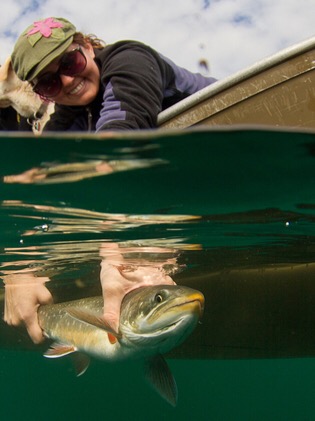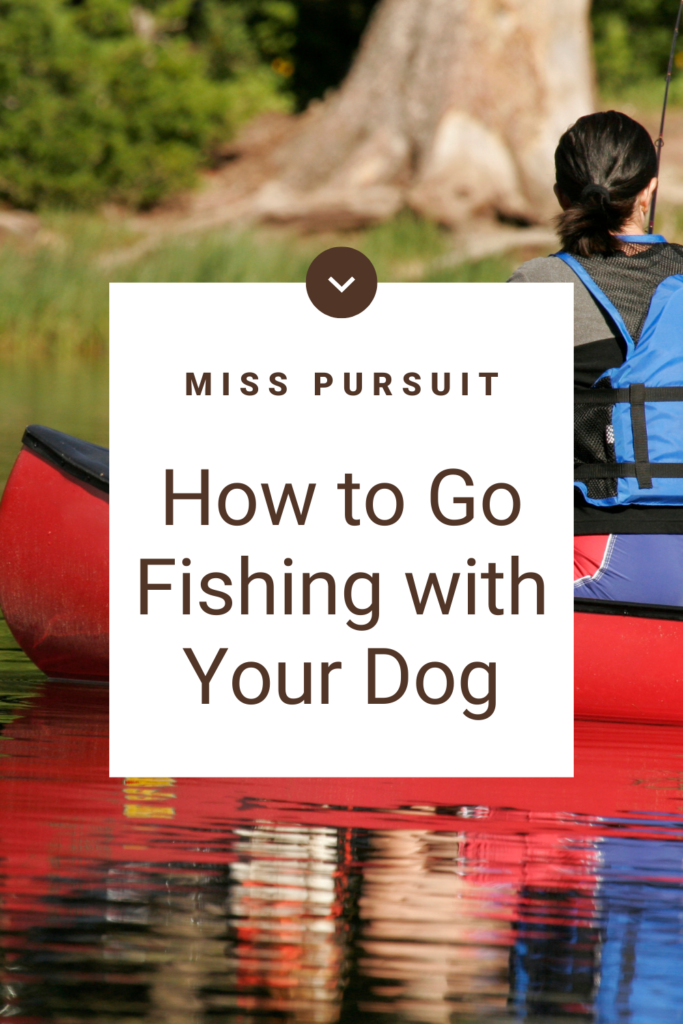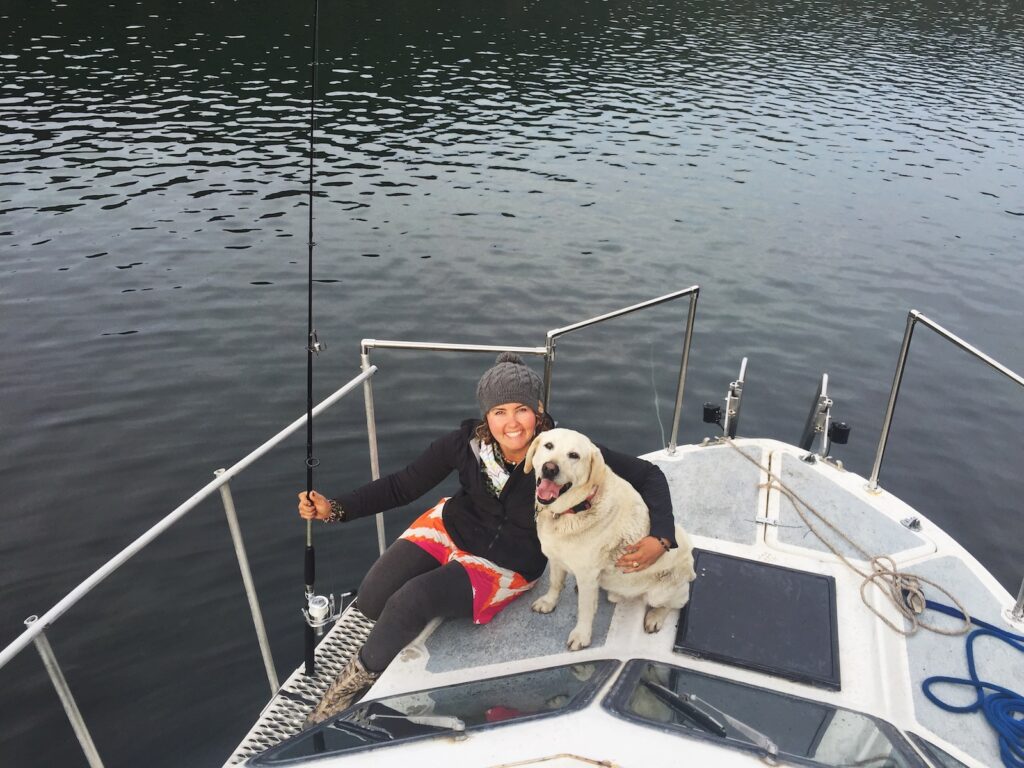Bringing your dog along for a fishing trip can be a rewarding experience for both you and your pet. And it can be thoroughly annoying and frustrating. The key difference lies in preparation and training.
It provides an opportunity for your dog to explore new environments and for you to enjoy the companionship. However, to ensure a safe and enjoyable outing, it's important to consider the preparation and training necessary for a successful fishing adventure with your dog.
Safety is a top priority when fishing with your dog. Before heading to the water, assess whether your dog is comfortable with the activity and the environment. If you plan to spend time on a boat, for example, your dog should be acclimated to the movements and confined space. Additionally, you'll need to equip your dog with a life vest, ensure their obedience training is solid, especially with commands like “stay” and “come,” and be aware of the risks associated with wildlife and fishing gear.

Essential Gear for Fishing with Your Dog
Equipping yourself with the right gear is crucial for a successful and safe fishing trip with your dog. Specific tackle, a dog-appropriate life jacket, and sufficient provisions for your canine companion will ensure both your enjoyment and your dog's well-being.
Choosing the Right Fishing Tackle
Choose a fishing tackle that is suitable for the environment and the type of fishing you plan to do. Keep in mind:
- Size of Hooks: Opt for hooks that are big enough to not be a swallowing hazard for your dog.
- Type of Line: Select a fishing line that minimizes the risk of tangling, especially if your dog is energetic and likes to move around.
Securing a Dog-Friendly Life Jacket
A life jacket is a non-negotiable safety item for your dog. Here’s how to choose the best one:
- Proper Fit: Measure your dog's size accurately and find a life jacket that fits snugly to ensure they stay afloat without discomfort.
- Visibility Features: Bright colors and reflective strips are essential features to keep your dog visible at all times.
Packing Food and Water Supplies
Food and hydration are fundamental needs for your dog, especially on longer trips:
- Food: Pack enough for the trip duration plus a little extra, in case you stay out longer than planned.
- Water: Bring plenty of fresh water to keep your dog hydrated; consider collapsible bowls for easy storage and access.

Preparation and Training
Before venturing out on a fishing trip with your dog, adequate preparation and specific training are crucial to ensure safety and enjoyment for both you and your canine companion.
Read it:: Comparing American Labs and English Labs: A Comprehensive Analysis
Obedience and Commands
Your dog should have a solid grasp of basic commands such as sit, stay, come, and leave it. Consistency with these commands can prevent potential disruptions or dangers during the trip. Practice in a variety of environments to ensure your dog's responsiveness regardless of location. Implementing a leash during the early stages can enhance control and establish boundaries.
- Essential Commands:
- Sit: To keep your dog stationary when needed.
- Stay: To maintain position while you cast the line or manage fish.
- Come: For reliable recall away from hazards.
- Leave it: To prevent tampering with bait or equipment.
Swimming and Water Familiarization
Even if your dog belongs to a breed known as natural swimmers, ensuring comfort and safety in and around water is vital. Introduce your dog to water gradually, and always supervise swimming sessions. A life vest for dogs can provide extra safety, especially in strong currents or deep waters.
- Swimming Checklist:
- Adaptable to water: Start in shallow areas and slowly increase depth.
- Safety gear: A well-fitted life vest is recommended.
- Supervision: Never leave your dog unattended near water.
Introducing Your Dog to the Fishing Gear
Acquaint your dog with fishing gear in a controlled environment to prevent fear or over-excitement on the day. Allow your dog to inspect and become comfortable with the sights, smells, and sounds of rods, reels, and tackle. Praise and treats can be used to reinforce calm behavior around the gear.
- Gear Familiarization:
- Show: Let your dog see and sniff the fishing gear.
- Sound: Allow them to become accustomed to the noise of the reel.
- Reward: Use positive reinforcement to create positive associations.
Selecting the Ideal Fishing Spot
When you plan to go fishing with your dog, selecting a location that ensures both fun and safety for you and your pet is crucial. Take into account the type of water, potential hazards, and local regulations.
Freshwater versus Saltwater Considerations
Freshwater:
- Pros: Often calmer waters; easier for dogs who might be new to fishing trips.
- Cons: May have more restricted areas due to wildlife.
Saltwater:
- Pros: Often more open areas allow dogs.
- Cons: Currents and tides can be stronger, which poses a greater risk.
Assessing Safety and Accessibility
- Safety: Look for a fishing spot within a reasonable radius that is free of dangerous wildlife, and check for a shore that offers stable footing to prevent falls or injuries.
- Accessibility: Ensure the fishing spot is easily reachable with your dog, preferably without having to navigate difficult terrain that could be hazardous for them.
Understanding Local Leash Laws
- Leash laws: Research and comply with local leash laws; some areas might require your dog to be leashed at all times, while others may offer off-leash areas.
- Enforcement: Be aware that leash laws are often strictly enforced to protect local wildlife and ecosystems around fishing areas.
By considering these factors, you'll be equipped to choose a fishing spot that's enjoyable and safe for both you and your dog.
Health and Safety Measures
When taking your dog fishing, prioritizing their health and safety is crucial. Pay close attention to preventing water-borne infections, protecting your dog from fish-related hazards, and ensuring they have ample shade and rest.
Prevention of Water-Borne Infections
To prevent water-borne infections, you should ensure your dog doesn't drink stagnant water or swim in areas with a visible algae bloom, which can harbor harmful bacteria. Always rinse your dog with clean freshwater after swimming, and dry their ears thoroughly to prevent ear infections.
- Water Safety:
- Avoid stagnant or algae-filled water
- Rinse your dog after swimming
- Dry ears to prevent infection
Protecting Your Dog from Fish-related Hazards
Keep raw fish out of your dog's reach as it may carry parasites and bacteria like salmonella. Ensure that your tackle and hooks are stored securely away from your pet to prevent injuries.
- Fish and Equipment Safety:
- Store tackle and hooks securely
- Prevent access to raw fish; parasites and bacteria are a risk
- Monitor your dog for any signs of distress or injury
Ensuring Shade and Rest Opportunities
Direct sunlight and excessive activity can lead to overheating and dehydration. Provide a shaded area for your dog to retreat to, and ensure they rest regularly, especially during the warmest parts of the day.
- Shade and Rest:
- Offer a comfortable and shaded spot for rest
- Encourage regular breaks to prevent overheating
- Provide plenty of water to maintain hydration
By following these health and safety measures, your fishing trip with your furry companion can be both enjoyable and safe.
Getting to Your Fishing Destination
Ensuring safe passage for your dog on land or water is paramount when heading out to fish. Your dog’s comfort and safety are as important as any prep work you do for the fishing itself.
Safe Transport in a Vehicle
When transporting your dog by vehicle, secure them with a crash-tested harness or in a properly-sized travel crate. It's important for their safety and to prevent distractions while you're driving.
- Crash-tested harness: Select one that has been proven to withstand the force of a collision, keeping your dog safe in the event of an accident.
- Travel crate: Should be large enough for your dog to stand, turn around, and lie down comfortably. Make sure it's anchored securely to the vehicle.
Check the crate or harness routinely for wear and tear and replace it when needed. Also, never leave your dog unattended in a parked vehicle, especially in warm or cold weather, to prevent heatstroke or hypothermia.
Boating with Your Dog on Board
Ensure your dog has a well-fitted life jacket even if they are good swimmers. Keep a close eye on them to protect them from the boat's movement or unexpected water conditions.
Preparing your dog for the boat:
- Conduct a trial run on the boat while it's docked to let your dog get used to the space and the motion.
- Use anti-slip mats to provide stable footing.
- Designate a safe, sheltered spot where your dog can rest.
Remember to have fresh water available and take frequent breaks, allowing your dog to relieve themselves and prevent seasickness. Your alertness to their needs ensures a pleasant journey to your fishing destination.

Fishing Day Dynamics
When you bring your dog along on fishing trips, the dynamics of your day change. Your dog becomes your fishing buddy, requiring additional preparations and safety measures to ensure a smooth experience. From setting up your fishing space to managing your dog's behavior, you must pay attention to the basics for a successful outing.
Setting Up Your Fishing Space
To avoid unnecessary entanglements or accidents, secure your fishing gear before your dog roams the area. Ensure that hooks, lures, and other tackles are kept out of reach. When choosing a spot, look for a stable shoreline or a steady boat if you're on the water. This will help avoid situations where your dog might jump into unsafe areas or disturb the fishing environment.
- Keep dangerous items secured: Store sharp tools and toxic substances like lead safely.
- Designate a dog-friendly zone: Create a comfortable space for your dog close to your fishing spot with a lead or tether, if necessary, for extra security.
Keeping Your Dog Engaged and Secure
Your dog must be engaged yet secure to prevent wandering off or creating disturbances. Train your dog to be comfortable and calm in the fishing setting. Bring along favorite toys or a bed so they can relax while you focus on fishing. If your dog is trained to handle off-lead situations, frequent check-ins and commands can help maintain control.
- Training: Work on basic commands like sit, stay, or come to manage your dog's movements.
- Entertainment: Provide chew toys or treat-dispensing toys that can keep your dog occupied.
Handling Potential Risks on the Shore and in the Water
Be aware of the risks associated with the fishing environment. Keep a vigilant eye on your canine companion, especially when casting lines to prevent any accidental hook injuries. If your dog enjoys swimming, ensure he understands when it's safe to jump in the water and the areas that are off-limits.
- Supervision: Actively watch your dog's behavior, especially during moments of heightened activity like casting or reeling in fish.
- Swimming safety: Teach your dog where and when it’s appropriate to swim and ensure they can safely jump in and out of the boat.
The Right Breed for Your Fishing Partner
Choosing the right breed for a fishing partner is crucial for a successful and enjoyable outing. Your dog should have characteristics suited for the environment and the activity of fishing.
Characteristics of Fishing Dogs
When looking for a dog to accompany you on fishing trips, you should consider breeds that possess a strong affinity for water and exhibit patient and obedient behavior. Stamina and a calm temperament are essential for long days by the water. Additionally, it is beneficial if the breed has a water-repellent coat and strong swimming ability to handle wet conditions.
- Affinity for Water: Enjoys being in or around water.
- Patient and Obedient: Willing to wait calmly for long periods.
- Stamina: Capable of enduring long days without tiring easily.
- Water-Repellent Coat: Helps to stay warm and dry.
- Strong Swimming Ability: Can handle being in the water if necessary.
Popular Breeds for Fishing Companions
Several breeds stand out as ideal partners for fishing due to their physical characteristics and temperament. Here are some breeds that are highly regarded as fishing companions:
- Golden Retriever: Known for their love of water and ability to retrieve. Perfect for trips where you may be catching fish like trout.
- Labrador Retriever: Labradors are one of the most popular choices due to their strong swimming skills and friendly nature.
- Chesapeake Bay Retriever: This breed is specifically known for its skills in water and its dense coat for insulation.
- Alaskan Malamute: While not a traditional fishing dog, they have a history of working closely with humans and are strong swimmers.
It's important that you consider the needs and abilities of these breeds alongside your own fishing habits to ensure a good match. Regardless of breed, introducing fishing gradually to ensure your dog is comfortable and safe is crucial for creating a successful fishing partnership.
Frequently Asked Questions
In this section, you'll find targeted advice on incorporating your dog into your fishing adventures, ensuring safety, obedience, and compatibility with various fishing practices and conditions.
What steps should I take to safely introduce my dog to boat fishing?
To safely introduce your dog to boat fishing, start by familiarizing them with the boat while it's stationary. Ensure they are comfortable maneuvering around and obey basic commands before heading out on the water. Life jackets made for dogs are essential for safety.
What are the necessary precautions for taking my dog fishing during cold weather?
When taking your dog fishing during cold weather, protect them with a waterproof coat or vest, especially if they have short hair. Limit their exposure to cold and wet conditions, and never allow them to walk on frozen water bodies due to the risk of breaking ice.
How can I use bread as bait while ensuring my dog's safety and obedience?
When using bread as bait, keep it out of your dog's reach to prevent ingestion, which could lead to stomach issues. Train your dog with commands like “leave it” to ensure they stay away from fishing gear and bait.
What breeds of dogs are most suitable for assisting with fishing activities?
Breeds that have a history of working alongside humans, such as Labrador Retrievers, are suitable for fishing due to their obedience, love for water, and retrieval instincts. However, individual temperament and training are important factors regardless of breed.
How do you train a dog to assist with fly fishing?
Training a dog to assist with fly fishing involves teaching them to stay calm and remain still to avoid scaring the fish. Start with basic training on land, then gradually introduce them to water, ensuring they understand and follow commands consistently.
Which dog breeds excel in fly fishing due to their natural traits and behaviors?
Dog breeds known for their swimming abilities and soft mouths, like Golden Retrievers and Portuguese Water Dogs, excel in fly fishing. These breeds have the tendency to gently retrieve and are comfortable in water, making them ideal companions for fly fishing.
